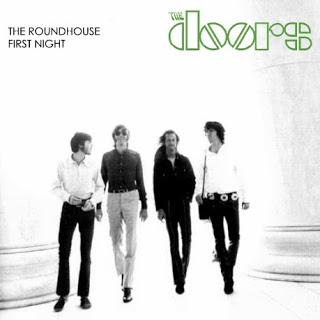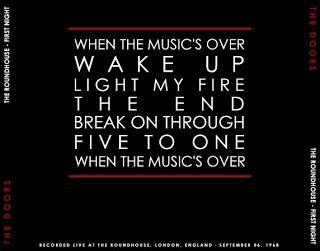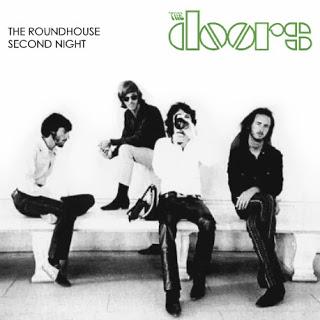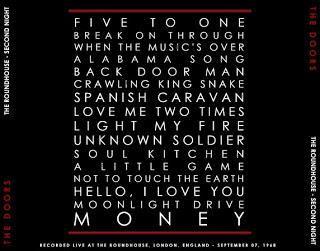

THE DOORS
The Roundhouse
London, England
1968-09-06
Format: mp3 320kbps
Tracklist:Early Show
01 - When The Music's Over (cut) 6:59
02 - Wake Up! 1:30
03 - Light My Fire 10:20
04 - The End 16:13
Late Show
05 - Break On Through (To The Other Side) 3:43
06 - Five To One 5:11
07 - When The Music's Over 11:53
Download:
http://nnzxkr.link-protector.com - mediafire


THE DOORS
The Roundhouse
London, England
1968-09-07
Format: mp3 320kbps
Tracklist:
Early Show
01 - Introduction 0:10
02 - Five To One 5:15
03 - Break On Through (To The Other Side) 4:02
04 - When The Music's Over 11:42
05 - Alabama Song (Whisky Bar) 1:42
06 - Back Door Man - Crawling King Snake 5:52
07 - Spanish Caravan 3:06
08 - Love Me Two Times 3:21
09 - Light My Fire 9:04
10 - The Unknown Soldier 4:14
Late Show
11 - Soul Kitchen 6:37
12 - A Little Game 1:48
13 - The Hill Dwellers 3:42
14 - Not To Touch The Earth 4:12
15 - Hello, I Love You 2:26
16 - Moonlight Drive - Horse Latitudes 6:05
17 - Money 3:21
Download:
http://nnzxks.link-protector.com - mediafire
From Greg Shaw's book The Doors On The Road:
About the 1968-09-06 show:
Both of these performances at the Roundhouse go exceptionally well. The band is in terrific form and Morrison, although a tad reserved in comparison to the summer performances, is in fine voice.
The late show opens with irrepressible energy from the band, with Morrison adding his graveliest snarl to the lyrics. The usually staid British audience breaks into applause at the introductory notes of "When the Music's Over" and Krieger rips into some fascinating Indian mantra—style leads during the piece. Morrison is quite animated during the gutsy "Back Door Man" and integrates "Crawlin' King Snake" into the midpoint of it while the band maintains the "Back Door" beat. Of note is their inclusion of a moderately abridged rare version of "Celebration of the Lizard." They conclude with a medley of "Moonlight Drive" intersecting with "Horse Latitudes" and wrapping up with the classic "Money."
London's Melody Maker comments on the early show: "He walked majestically on stage clad in a tight black leather suit, white shirt and brown shoes. The crowd applauded him and Morrison, taking a stance at the mike, smiled briefly and belted into his first song. His singing is every bit as powerful as the Doors albums suggest, while the backing trio of organist Manzarek, drummer Densmore, and Krieger, guitar, are really together and play with precision and timing that are quite remarkable. The Doors are undoubtedly one of the most professional groups on the scene anywhere. Everything hangs together well and there is an underlying feel of calculation and presentation which projects the music to its full [sic]." (Melody Maker, Sept. 14, 1968)
Both of these performances were filmed by Granada Television for the Doors Are Open special telecast on October 4, although the program used only footage from the second show.
On their first night, the Doors open for Iefferson Airplane, and on the following night the Airplane open for the Doors. The first night's performances are delayed while negotiations as to which band will appear first continue past 10:30 p.m. Initially, it had been determined that the Airplane would be first on the stage, but Granada Television pleads for the Doors, and the ensuing discussions continue for several hours while the audience remains remarkably patient. Advertisements for the shows announced the performance time as from 7:30 till dawn, so the audience was already anticipating a long night.
These shows are attended by many London music scene luminaries, including members of the Rolling Stones, Traffic, and the Crazy World of Arthur Brown.About the 1968-09-07 show:
The early show opens with some strong vocals and blistering guitar work on "Five to One." It sets the stage for the evening, which continues in the same vein. During "When the Music's Over," Krieger empts into a grinding, twisting, notebending guitar solo and Morrison's voice is coarse and sharp with precise inflections. This is a well-executed show right through to "The End," where Krieger again bursts into dramatic. crashing guitar chords with a twisting and churning that evokes a free-falling plunge. Near the conclusion of the song the difference between the British and American audience becomes evident. The British remain politely still during the quiet passage following the instrumental climax, while American audiences usually empt into cheers.
Jim Morrison later stated that he thought the late show on their second night at the Roundhouse was probably one of the band's best performances: "The audience was one of the best we've ever had. Everyone seemed to take it so easy. It was different because in the States they are there as much to enjoy themselves as to hear you. Whereas at the Roundhouse, everyone was there to listen. It was like going back to the roots again and it stimulated us to do a good performance. They really took me by surprise. I expected them to be a little resistant, a little reserved, but they were fantastic. That's all I can say. I enjoyed playing at the Roundhouse more than any other date for years." (Nick Logan, "Elvis influenced Doors Jim," New Musical Express, Sept. 21, 1968)
In l969, Jim reflected on the Doors’ European tour: "Well, a lot of people had cautioned us that there'd be a lot of hostilities towards an American group, but it didn't happen that way. The Germans were really boorish. but, other than that, the audiences were really great. Especially London, they were fantastic. It's probably the most informed, receptive audience I've ever seen in my life, the one at the Roundhouse. An old converted railway roundhouse now used for theatrical performances." (Hank Zevallos, "Jim Morrison," Poppin magazine, 1969)
From Stephen Davis' book Jim Morrison: Life, Death, Legend:
They flew to London via Air India on September 2, 1968. The Granada TV crew met them at Heathrow Airport and filmed them as they emerged from customs. On September 5 the Doors performed “Hello, I Love You” on the BBC’s Top of the Pops TV broadcast. The next day, Friday, September 6, the Doors played the first of their two legendary nights at the Roundhouse, an old, acoustically challenged former railway barn in Chalk Farm.
The early show went off well, but the late show was a killer. Originally scheduled to begin at ten-thirty, it was delayed by the Airplane’s (stunning) two-and-a-half-hour set and didn’t start until after one in the morning. Many of England’s pop aristocrats were there: Paul McCartney, George Harrison, Mick Jagger, Keith Richards, Cream, Traffic, and movie stars Terence Stamp and Julie Christie. As the Granada crew filmed every song, Jim performed with a contained passion and an animal grace that surprised even the other Doors and their crew.
They began with a deadly “Five to One” and tore through seventeen songs. “The Unknown Soldier” was rapturously received by the longhaired young crowd, since the English were generally against the American presence in Vietnam. Jim cut “Crawlin’ King Snake” into “Back Door Man,” then took the band through an abridged but dramatic “Celebration of the Lizard” that brought down the house. After “Hello, I Love You,” they went into “Moonlight Drive,” during which Jim recited “Horse Latitudes.” After a howling ovation, the Doors came back and jammed on “Money” until the gray London September dawn suddenly broke through the Roundhouse’s glass skylights, an epiphany for everyone present.
After a few hours rest, the Doors held an afternoon press conference at London’s Institute for Contemporary Art, where Jim thoughtfully fielded questions and deflected political criticism by saying that songs like “The Unknown Soldier” spoke for themselves. Densmore: “Jim dazzled the reporters with his rhetoric. He controlled the conversation with long pauses between sentences while he weighed his answers. You could see the wheels turning as he took the maximum time tolerable before responding.”
When a reporter asked about comparisons with Mick Jagger, Jim answered: “I’ve always thought comparisons were useless and ugly. It’s a shortcut to thinking.” Another asked about fans coming to him for advice. “I get incredible letters,” Jim said, warming to the subject. “But they teach me how to live rather than me teaching them. My fans are intelligent youngsters. Very sensitive people.”
That night they again played two shows at the Roundhouse. The Airplane, English rock singer Terry Reid, and the Crazy World of Arthur Brown played first. Robby Krieger had gotten over his jet lag and treated the audience to a psychedelic guitar display that burned with fire and originality. The second show again finished at dawn with a half-hour reading of “The End,” during which the crowd sat quietly transfixed, as if they were attending a solemn rite.
Jim later said this second Roundhouse show was the Doors’ zenith performance. He told New Musical Express, “The audience was one of the best we’ve ever had. In the States, they’re there to enjoy themselves as much as they came to hear you. But at the Roundhouse, they were there to listen. It was like going back to the roots. It stimulated us. They took me by surprise, because I expected them to be a little resistant, a little reserved. We’d been cautioned there might be hostility toward an American group. But they were fantastic, is all I can say. It was probably the most informed, receptive audience I’ve ever seen in my life. I think I enjoyed the Roundhouse more than any other date for years.”
My notes:
According to the research by Len Sousa on his wonderful site thedoorsguide.com, all the recordings of these shows have been mislabeled for years. In brief, the tracks believed to belong to one evening actually belong to the other, and vice-versa. For this reason I rearranged the songs in order to match Len's reconstruction, and I edited the covers to reflect this change. I suggest reading his article for extended information. Also in consideration of this, you should read the above comments of Greg Shaw and Stephen Davis as referred to the wrong evening.
This said, the shows at the Roundhouse are widely recognised as one of the best performances of The Doors. The singing skills of Jim and the mastery of the musicians are the top of their "first period", before the failed experiment of The Soft Parade and the return to the blues sound of the last two albums. And also before the strong contrasts within Jim and the rest of the band, originated by the attempted selling of "Light My Fire" for use in a Buick Opel TV commercial while Jim was still in London, and carried on by Jim's alcoholism and disinterest towards the recording sessions.
The tapes we have here are audience recordings. The tape of the first evening has the best quality, although it's certainly missing some songs. The second tape includes the whole first set and a good portion of the second, but it's more screechy (especially on songs like Soul Kitchen, which also has a small cut).
Luckily, a part of these essential shows has been captured on video. The most important document is the one hour documentary The Doors Are Open by Granada TV, which partially shows the first set of the second evening and also includes interviews and soundchecks. Hadn't it be filmed in black and white and with a poor audio equipment, this would have been the definitive movie of The Doors in concert, much better than the overrated Hollywood Bowl video. The second document is an incredible 16mm amateur color film of Jim singing When The Music's Over from the first set of the first night. It's one of the few amateur films of which we also have the original audio to go with. This is the most amazing kind of document because Jim didn't know he was taped and he was free to express himself without being bothered by the cameras.
The Doors live at The Roundhouse 1968 color footage

